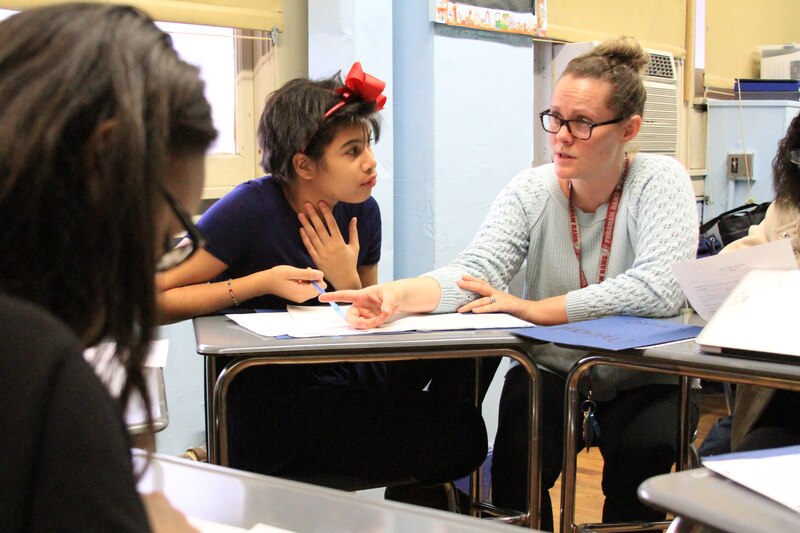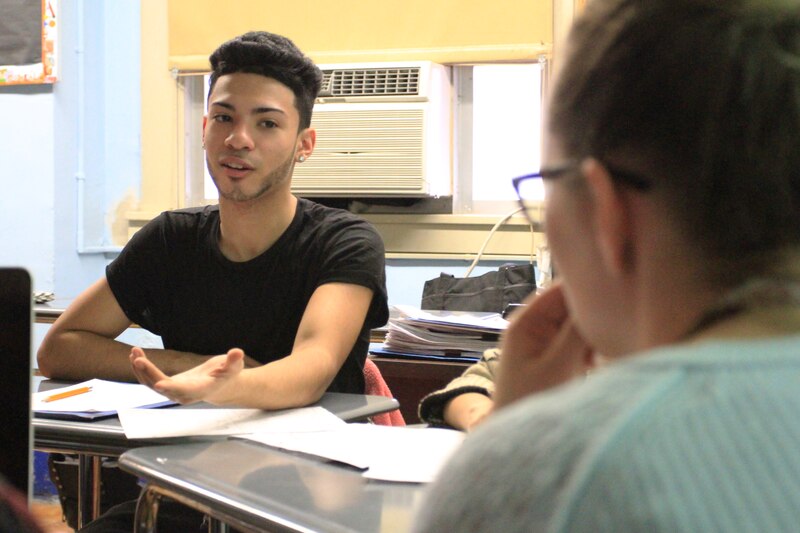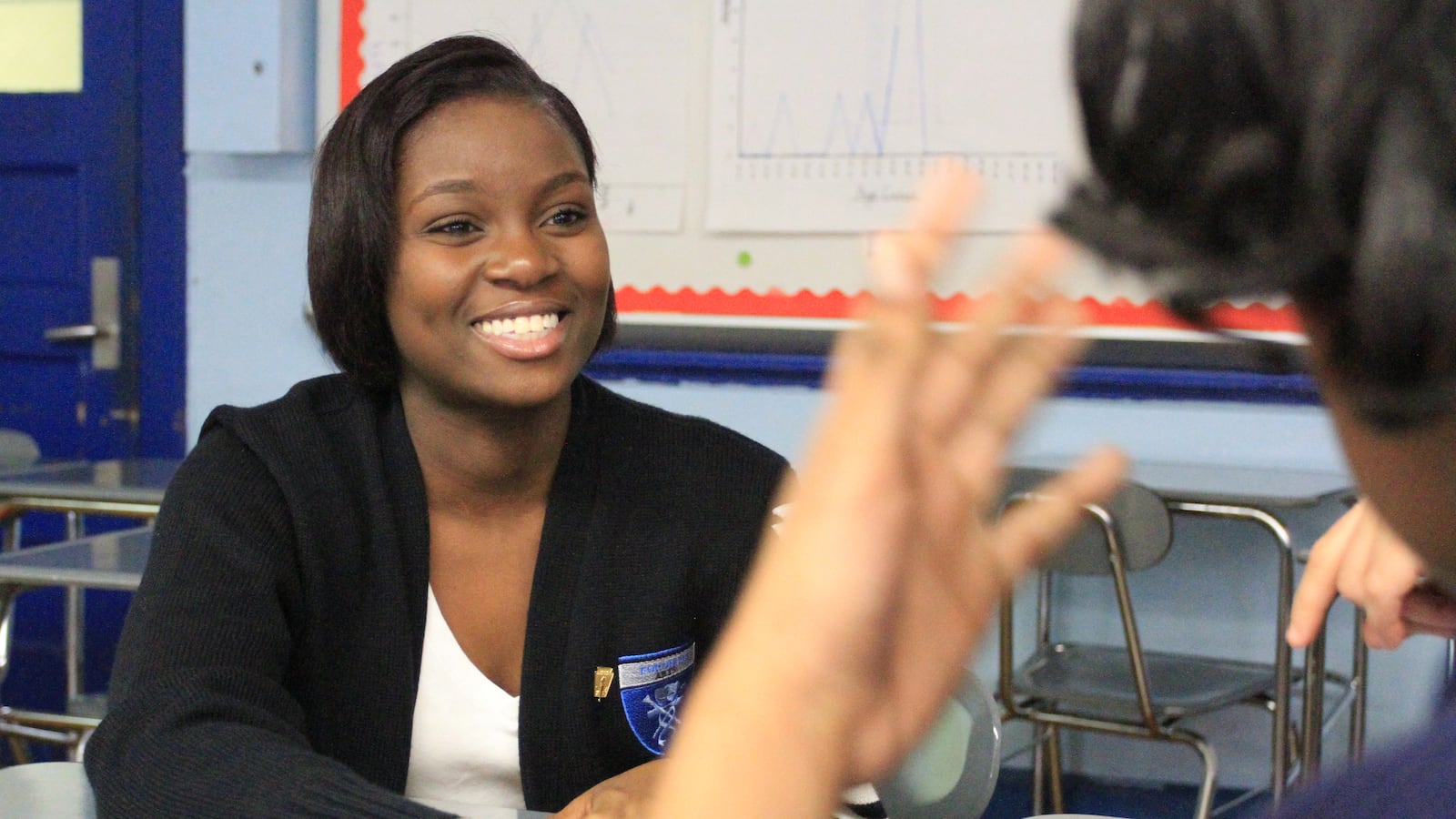When Samara McLendon looked at a list of colleges recommended for someone with her mix of grades and test scores, the 16-year-old didn’t see many that she recognized.
The private Skidmore College in Saratoga Springs was included, along with the University at Buffalo. So was SUNY Geneseo, which has a student population that is 74 percent white. The student population at McLendon’s Bronx high school is 2 percent white.
As the high school junior stared at the list of school names, she wondered aloud if she would fit in.
“How is the social aspect going to affect my learning?” McLendon said. “How does that play into the college that I choose?”
Her questions were prompted by an organization called OneGoal, a college-readiness program that provided McLendon with her list of schools. That program, which is now in eight New York City schools, recruits educators to teach a course that covers everything from how to get financial aid to how to choose where to apply to college.

But the teachers dive deeper than explaining the Common Application. They also have frank discussions with students about what it will be like to on campus, which might involve any number of challenges for those moving out of the city. Some of those talks touch on tricky subjects like race and class.
“It’s not enough to get students into college,” said Nikki Thompson, the executive director of OneGoal in New York City. “Once they’re there, how do they survive?”
Research supports the idea that making students comfortable socially in college is key to ensuring that they graduate, said Gregory Wolniak, the director of the Center for Research on Higher Education Outcomes at New York University. That is particularly crucial for students from low-income communities, where only 9 percent of students typically graduate from college by age 24, according to a recent Pell Institute study.
That’s why teachers working with OneGoal tackle the topics head-on. They encourage students not to attend schools where a large percentage of students of color do not graduate. They also start discussions about what it might be like if the students choose schools where they are minorities for the first time.
“They don’t even think about race, or like racial tension, or racism, or prejudice. For some of them, they’ve never experienced it,” said Jennifer Blalock, one of OneGoal’s teachers at Fordham High School for the Arts. “And so it’s thinking, how do we get them prepared for an environment where they’re most likely going to come across that at some point?”
Dennique Khanns, a junior at Fordham High School for the Arts, had already started thinking about how much her choice should hinge on college demographics. She wants to attend Spelman College, a historically black college in Georgia, but wonders if narrowing her search to schools that serve mainly students of color will cut her off from other good options.
“I want to be in my safe zone,” she said. “And then I’m just like, but opportunities are open for predominantly white schools too. So it’s like, I’m still iffy about that.”

OneGoal encourages students to consider schools, like those in the SUNY system, that are both affordable and have better graduation rates than CUNY schools. (Among students who entered CUNY in 2006, only 30 percent of students had earned an associate’s or bachelor’s degree after six years. At SUNY, 64 percent graduated in six years.)
But SUNY schools are varied, with some in the suburbs, upstate cities, or small rural towns. Almost all have a very different look and feel to New York City, which means students will have to get acclimated to a different culture in an unfamiliar area.
One of those adjustments will likely be in the school’s racial diversity. Though state schools tend to be more diverse than other colleges, they still won’t look like the Bronx, said Risa Dubow, a counselor at BottomLine, another program that helps students through the college application process.
“A diverse SUNY is still not going to look like New York City,” she said.
Teachers can only hope their lessons about college life will help students once they get to school, but sharing information about the application process can make a quick and tangible difference in where students apply to college.
OneGoal is there to fill in the gaps in student knowledge about everything from tuition costs and to realistic academic expectations. Students with 2.0 grade-point averages sometimes want to attend Ivy League schools. Others, like McLendon, don’t realize that in-state tuition is cheaper than out-of-state tuition.
“For a lot of them, the messaging is just ‘get to college,’ but the conversation doesn’t go past that,” Blalock said. “The conversation doesn’t go to, ‘OK, but what’s the pathway? How do I get there?’”

